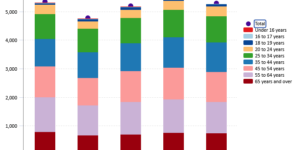When Antonio Bravo stepped into the Salinas, California, hotel in May 2020, he first noticed a foul smell. Then he saw the bare metal cot with no mattress that his employer had given him to sleep on after working long days in the fields.
“My spirits fell when I saw that place,” said Bravo, a guest worker recruited from Michoacán, Mexico by a company that supplied farms with workers to pick strawberries for brands like Driscoll’s. “I couldn’t breathe.”
There, at the aging downtown hotel, he and his roommates say they often waited in line until midnight to use one of only two-and-a-half bathrooms the company provided for dozens of workers. Rats and cockroaches roamed the rooms, they said, and they took turns sleeping in the one comfortable bed in their room.
When the workers asked a supervisor to eradicate the bedbugs in their room, they say he told them to buy their own insecticide. One of Bravo’s roommates, Francisco Magaña, said he took to rubbing himself with alcohol at night to keep the bugs away.
Through an attorney, Bravo, Magaña and one other worker complained about these conditions to state regulators, who visited the hotel in the summer of 2020 but said in inspection records they found no violations of state law. The workers say conditions on their floor didn’t change.
As the number of agricultural guest workers like Bravo has risen dramatically in California, the episode highlights how state regulators have struggled to ensure that farms are providing safe housing to their workers.
The state’s Department of Housing and Community Development employs just three inspectors to oversee all employer-provided dwellings, across a state that spans more than 150,000 square miles and provides over a third of the country’s vegetables and nearly three-quarters of its fruits and nuts. The department conducts all its routine housing inspections before workers move in, which makes it difficult to catch such issues as overcrowding.
When its inspectors do find issues, employers face few consequences, department records show. Despite identifying 1,053 violations in employee housing facilities in 2022, the last year for which data is available — including electrical hazards and exposed wiring, mold, living rooms with more than seven beds, missing fire extinguishers and windows that didn’t open — the department did not issue a single citation.
And, in at least a handful of recent cases, inspectors awarded permits to employer-provided housing without ever visiting the site, CalMatters found.
While other state and federal agencies also play a role in protecting agricultural guest workers’ rights, the gaps in the housing department’s inspections cast doubt on whether a key part of the state’s oversight system is working.
In the case of workers like Bravo, it can take an outside entity to address the problem head-on. Change came only after Bravo’s attorney, Josephine Weinberg of California Rural Legal Assistance, threatened to take employer PGM Packing to court. The company agreed in a 2022 settlement to compensate Bravo and two other workers, stop housing workers at the Salinas hotel and provide workers with beds and bedding, though the company didn’t admit any liability.
Weinberg said she felt vindicated. But she also wished state regulators had taken action earlier.
“I was waiting for something from Housing and Community Development for quite a while and then just didn’t get it,” she said. “The message I was getting broadly was ‘We don’t have jurisdiction and the things you’re telling me about I can’t do anything.’ Or ‘I’ll look into it’ and it was never resolved.”
PGM Packing didn’t respond to repeated requests for comment. It employed Bravo through the H2A visa program, which allows U.S. employers to hire temporary workers from abroad – mostly from Mexico – for agricultural jobs that are not filled by domestic workers.
H2A workers do everything from harvesting wine grapes in Santa Barbara to splitting beehives in Sutter Creek. Under federal and state law, their employers must provide them safe and clean housing. California law tasks the housing department with inspecting employee housing annually, including H2A housing. The department also investigates when workers or community members file complaints.
As the number of H2A workers in California has nearly tripled in the last six years to 41,000 last year, the housing department has acknowledged the difficulty of keeping up.
Housing and Community Development officials said in a 2020 budget request that the department was so understaffed it was only inspecting about 25% of employee housing facilities annually.
Since then department officials say increased state funding has allowed them to step up enforcement, creating a special unit to focus specifically on employee housing and inspecting every employer who applied for a worker housing permit in 2024.
Officials say that they plan to hire an additional five inspectors and that they are striking the appropriate balance between protecting workers and ensuring due process for businesses.
Department spokesman Pablo Espinoza said “the system seems to be working.”
“Nothing is ever perfect,” he added.
Still, the state currently employs only about one employee housing inspector for every 14,000 H2A workers, fewer than in some other states with large H2A populations. Washington, for example, has one inspector for every 7,000 workers and unlike California, posts inspection results online. North Carolina has about one inspector for every 4,000 workers. Michigan has about one for every 2,000, and inspectors regularly visit farmworker housing both before and after it’s occupied, a spokesperson for the state’s agriculture department said.
Ignacio Ornelas Rodriguez, a Stanford historian who has studied the history of migrant farm workers in California, said without better enforcement, farmworkers will continue to live in appalling conditions. He said the state also risks more tragedies like last year’s shooting of eight workers on two mushroom farms in Half Moon Bay, where workers were living in uninsulated sheds before a disgruntled coworker opened fire.
“So, to me, that really is a tragedy,” he said upon hearing of the department’s low citation rate. “Because as a historian, what are we waiting for? Are we waiting for that terrible accident?”
Housing Department officials have also noted that poor housing conditions don’t just imperil farmworkers, but the entire food supply. “Overcrowding and unsanitary conditions can trigger communicable diseases, among them foodborne diseases such as Norovirus, E-coli, Listeria, Salmonella, and Hepatitis A,” department officials wrote in their 2020 budget request. “Such illnesses can contaminate food products, especially those designed to be consumed raw.”
Among the most vulnerable tenants in a state plagued by a housing crisis, H2A workers must depend on their employers to maintain their legal status. Their employer-provided housing is often hidden away behind a guarded gate or down a rural road, out of sight of the public and of worker advocates who could draw attention to exploitative conditions. That makes state oversight even more important, advocates say.
“The laws on the books are not the laws in the fields,” said United Farm Workers President Teresa Romero. “No matter how bad the conditions are, the worker can’t quit and go to the farm down the road.”
‘Wow, how is this even approved?’
Francisco Ocampo was working as assistant district director for the U.S. Department of Labor’s Los Angeles office in 2022 when, he said, he got a tip: Rancho Nuevo Harvesting, a large H2A labor contractor based in Santa Maria, in one of the world’s major strawberry-and vegetable-growing regions, might be violating federal labor laws.
As the use of H2A labor exploded along California’s Central Coast over the past few years, he and his team had coursed through the region’s farms, he said, investigating workplace and living conditions. They’d find workers sleeping on floors and living without potable water. Sometimes, Ocampo said, they’d encounter farmworker housing that was so dilapidated, “We’re kind of like, ‘Wow, how is this even approved?’ ”
He and his Department of Labor colleagues are in charge of making sure farmers provide H2A workers a safe place to stay, transportation, meals or cooking facilities and a minimum wage, which they do through targeted investigations. But it’s the California Department of Housing and Community Development that inspects and approves housing for H2A workers and other employees.
Ocampo said that in some cases, the state appears to be performing only cursory inspections of housing, or signing off on it without visiting. “When we’re talking to the housing providers they tell us, ‘No, no vino nadie’ ” – nobody came to inspect – ” ‘but we got this approval.’ ”
Last fall, a federal court ordered Rancho Nuevo Harvesting to pay more than $1 million in back wages and penalties after Ocampo and his team found that the company had housed workers in facilities that didn’t meet federal standards, fed them spoiled food, and failed to provide required transportation, according to court documents.
Rancho Nuevo, which agreed to the consent judgment, didn’t respond to multiple requests for comment.
At one Ventura County house managed by Rancho Nuevo, Ocampo said, investigators who visited in 2022 were “appalled” to see signs warning that the water was unfit for human consumption.
State inspectors hadn’t visited the house since 2019, inspection records obtained by CalMatters show, despite the fact that they had found violations in their last inspection. Housing department officials said the missed inspections were due to an administrative error.
Even as Ocampo and his colleagues were investigating Rancho Nuevo, records show, state regulators approved a permit for farmworker housing at one of the company’s other facilities – without ever stepping foot inside it.
Instead, a Rancho Nuevo manager used a video call to guide a state inspector through a single-family home on a Riverside County farm, according to department records obtained by CalMatters. Agency officials acknowledged at least three additional instances of virtual inspections at other farms in 2023, a violation of Housing and Community Development department policy.
Mitchel Baker, the department’s assistant deputy director for codes and standards, said a supervisor had signed off on the virtual visits because the housing was in isolated areas of the state where it was difficult for inspectors to find lodging. He said inspectors have been told not to do virtual visits again.
Ocampo – who now runs the Labor Department’s San Jose office – acknowledges that, even as his agency has aggressively pursued investigations, the rise in H2A workers makes it hard to stay ahead of the problems. “We barely touch the tip of the iceberg,” he said.
He said investigations are complicated by the fact that growers and labor contractors will sometimes house workers in a different location than the one they list on their H2A application, or allow conditions to deteriorate after the housing department conducts inspections.
“They know in the industry that they’re just going to do the pre-occupancy inspection and that’s it, and walk away,” he said. “And that leads them to put up the nice front and then move people to a different location.”
Better cooperation between his office and California regulators, he said, could maximize agencies’ resources and put farmers on notice that housing violations carry consequences.
Thousands of violations, one citation
Since state regulators only schedule farmworker housing inspections before workers move in, they rely on complaints to catch any problems that emerge afterward. But unlike Bravo, most H2A workers don’t report housing violations, advocates say.
“If they complain, they’re blacklisted and then they don’t get these jobs. These jobs allow them to send a lot of money back,” said Natalie Herendeen, executive director of the Center for Community Advocacy in Salinas, which organizes for better housing for farmworkers.
State inspectors need to do regular unannounced visits when housing is occupied and give workers a chance to be interviewed anonymously, out of earshot of the employer, Weinberg said. “If you don’t speak to the people who are living there day in and day out, if you don’t go into people’s actual residences when they’re there, I don’t know how you’d have an understanding of what the conditions are.”
State officials say they’re hampered by California’s employee housing law, which says that inspectors “shall make every effort to complete the inspection prior to the occupancy of the employee housing.”
Even when state inspectors find employee housing violations, they almost never use the full power California law grants them to punish the companies responsible.
California’s employee housing law says accommodations must be safe and sanitary, with comfortable beds, enough bathroom facilities for the number of workers, and protection from the cold and animal infestations.
On paper, the penalties for violating these provisions are strict, and even creative: Employers can be charged with a misdemeanor and either fined $2,000 or jailed for six months. Regulators can also issue citations that carry a penalty of up to $300, or go to court and collect up to $1,000 for each day that a violation continues, with penalties doubled if there’s an immediate threat to workers’ health and safety. Employers convicted of violating employee housing laws twice in five years can even be sentenced to live in their own employee housing for up to a year.
But the department did not issue any citations or assess any penalties from 2019 through 2022, its last four annual reports show — despite finding thousands of violations.
The state contracts out a small portion of its enforcement to local cities and counties whose work it oversees; just one of those, Tulare County, issued a single citation in 2020, according to the reports.
Instead, inspectors tell employers to correct the deficiency and charge them a one-time fee of $223 to reinspect the property before workers move in. Baker said the reinspection fee serves as a deterrent and the state rarely has to resort to stricter measures. He provided data showing that just 4% of employee housing operators failed their initial inspections from January to mid-June of 2024.
“In large part we have really good farm labor contractors,” he said. “We tend to see that the majority of them are passing inspection on the first time.”
But that strategy does not seem to have worked in the case of Rancho Nuevo, which was assessed a reinspection fee by the housing department in 2019 and, according to the court judgment, continued to violate the law.
And U.S. Labor Department investigators say their experience shows the threat of fines can inspire employers to take action to upgrade housing. After the Labor Department assessed one Santa Maria-based labor contractor $1,800 in penalties for housing and transportation violations, for example, the owner added QR codes to items in workers’ housing that they could scan to report any problems, Ocampo said.
Sometimes, as in Bravo’s case, inspection reports don’t match the experiences of the workers.
Inspectors visited the Salinas hotel at least twice in the summer of 2020, Bravo and Magaña say. During one visit, Bravo saw the third floor, where he and other workers lived, blocked off with caution tape. In another visit, Magaña said, inspectors peeked into rooms but he did not see inspectors enter them or interview any workers.
Housing and Community Development officials confirmed that an inspector visited the Salinas hotel in July 2020 but said they found no violations of California’s employee housing law or regulations. In response to workers’ complaints about bedbugs and unclean bathrooms and bedding, the inspector wrote in a report, “The Department of Housing does not regulate housekeeping at employee housing facilities.”
The department’s own regulations, however, say that employee housing “shall be kept clean and free from vermin, vectors and other matter of an infectious or contagious nature.”
Bravo said things were no better in the Central Coast town of Santa Maria, where PGM moved him to work the fall strawberry harvest. There he slept for weeks on a hallway floor in a three-bedroom house where more than 20 other workers camped out, he said, some crashing in the kitchen and on an outdoor patio.
Records show PGM hired out the workers to at least one supplier of berry behemoth Driscoll’s, whose plastic containers are ubiquitous in neighborhood supermarkets. The company told CalMatters its labor standards require growers’ employee housing to be “clean, safe (and) meet the basic needs of workers,” and that it was in contact with the farm in question about the issue.
Again Bravo’s attorney complained about his living conditions, writing a letter to PGM and copying state and federal officials. Department of Housing and Community Development records show the agency opened an investigation in November 2020, but closed it days later with a case report containing a single-sentence summary: “No violations noted.”
‘You guys are in heaven’
Early evening light slants into the windows of the spacious ranch house surrounded by the green vistas of Santa Rosa’s Balletto Vineyards. A van pulls up outside, and a group of farmworkers jump out carrying groceries.
They bustle into the house, dropping tortillas and bottled water on the villa’s long communal table and divvying up meat in the industrial kitchen. Some men lounge on the wide porch outside, while another tends to the melons, chiles and cilantro in the adjacent garden.
Alejandro Luna has been making the annual trip from Mexico to Santa Rosa’s Balletto Vineyards for the past seven years and says the ranch house feels like home. His employer stocks the kitchen with utensils and allows workers to use the farm’s vans when they need to make a trip to town.
The United Farm Workers represents Balletto’s employees and has negotiated and helped enforce the same conditions for guest workers as for their local coworkers, including paid holidays, harvest bonuses, premium pay for night work, and shades to protect them from the heat.
Luna has heard stories from other guest workers about employers who packed them all into a single room, charging illegally for rent and transportation. “They tell us, ‘You guys are in heaven. You have everything,’ ” Luna said.
New Department of Labor rules that took effect last week will make it easier for unions and community groups to organize guest workers, by guaranteeing the groups’ access to visit workers in employer-sponsored housing.
“We’ve seen a massive growth in demand for H2A workers, which drives home the importance of ensuring that those workers are protected,” Acting Labor Secretary Julie Su said at a press conference in April. “Housing should be humane, it should be decent.”
Su pointed to Balletto as an example that “it is possible.”
“Some will say our business model requires us to do certain things that are detrimental to worker wellbeing. I just don’t buy it.”
Back in Mexico, Bravo says he has suffered from chronic insomnia for the past several years, which he says his doctor attributes to the sleepless nights he spent in California. He used his earnings from his work in the U.S. to start a small business, but then thieves stole the well-drilling equipment he’d purchased.
So this year, he’d planned to return to California for the strawberry harvest, “to start again from zero.”
Then he heard from some former coworkers that the company he planned to work for was housing 56 workers in a motel with just two bathrooms. Bravo decided to stay put.
“You go with the hope of overcoming, of being happy and being able to complete your work well,” he said. “But then it turns out when you arrive that things are really different.”
Erica Yee contributed to this report.
This story was originally published by CalMatters and distributed through a partnership with The Associated Press.





















 Reporter’s Notebook: ‘Nobody Else Does Telematics,’ Lemonade Exec Says
Reporter’s Notebook: ‘Nobody Else Does Telematics,’ Lemonade Exec Says  Surviving the ‘Silver Tsunami’: Closing the Talent, Skills Gap in Underwriting
Surviving the ‘Silver Tsunami’: Closing the Talent, Skills Gap in Underwriting  Dear Elon and Vivek: Insurance Commissioners Urge DOGE to Ditch FIO
Dear Elon and Vivek: Insurance Commissioners Urge DOGE to Ditch FIO  Swiss Re’s Business Unit CEOs Share Views on Key Risk Themes of 2025
Swiss Re’s Business Unit CEOs Share Views on Key Risk Themes of 2025 